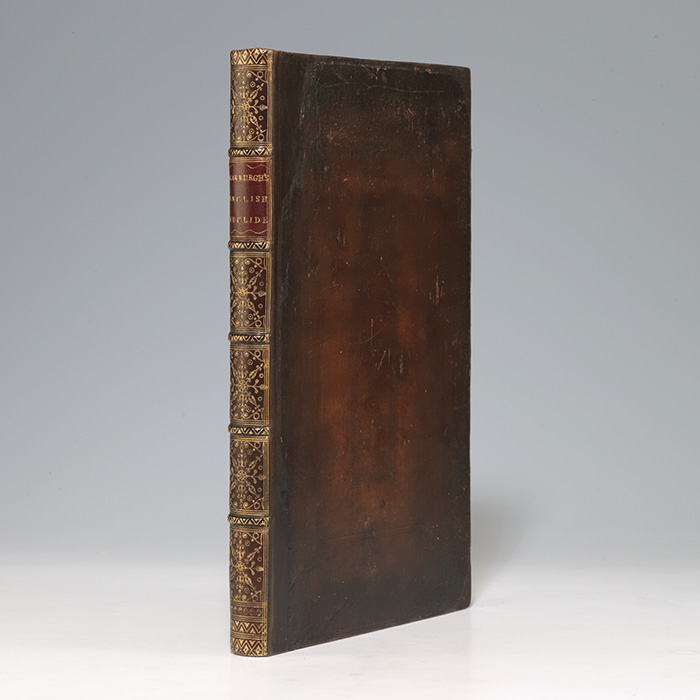
"NO WORK CAN COMPARE TO EUCLID'S ELEMENTS IN SCIENTIFIC IMPORTANCE": FIRST AND ONLY EDITION OF THE ENGLISH EUCLIDE, 1705
(SCARBURGH, Sir Charles) EUCLID. The English Euclide, Being the First Six Elements of Geometry, Translated out of the Greek, With Annotations and useful Supplements. Oxford: Printed at the Theater, 1705. Folio (9-1/4 by 13-3/4 inches), contemporary paneled brown calf rebacked in elaborately gilt-decorated calf, red morocco spine label, raised bands; (xii) (1) 2-282. $7500.
First edition of English Euclide, featuring the translation and commentary of the preeminent 17th-century mathematician and royal physician Sir Charles Scarburgh, a founding Fellow of the Royal Society and an assistant and successor to William Harvey, published from Scarburgh's manuscript and issued posthumously, profusely illustrated with woodcut-engraved diagrams.
"No work can compare to Euclid's Elements in scientific importance" (Rosenbach 19:225). Authored by Euclid in the 4th century B.C., "this is the basic treatise in geometry. 'No work presumably except the Bible has had such a reign'" (Horblit 27). "Euclid's Elements is a compilation of all earlier Greek mathematical knowledge since Pythagoras, organized into a consistent system so that each theorem follows logically from its predecessor; and in this simplicity lies the secret of its success. Of the 13 books into which it is divided, numbers 1 to 4 are on plane geometry; 5 and 6 on the theory of proportion due to Eudoxus and its application; 7 to 9 on the properties of numbers; 10 on irrational quantities; 11 to 13 on solid geometry culminating in the proof that there are only five regular solids; books 14 and 15 were added later but are not by Euclid… The Elements remained the common school textbook of geometry for hundreds of years" (PMM 25, citing the 1482 first edition published in Venice by Erhard Ratdolt).
The first edition of The English Euclide, from the manuscript of the eminent 17th-century physician and mathematician, Sir Charles Scarburgh, was published posthumously by his son, whose name appears on the title page. "A founding Fellow of the Royal Society, Scarburgh loved mathematics and medicine equally. He discoursed on Euclid and trigonometry with the same passion as on muscles" (Furdell, Royal Doctors, 169). Scarburgh was early mentored by William Harvey and by 1645 "was assisting Harvey in writing his De generatione animalism… in 1656 Harvey chose him as his successor at Lumleian lecture." At Harvey's death, he bequeathed his velvet gown and "silver instruments of surgerie [sic]" to Scarburgh, who was named first physician by Charles II and knighted in 1669. According to John Evelyn, Scarburgh's library contained "the very best collection, especially of mathematical books… in Europe." At his death in 1695 "Scarburgh left materials for an English edition of Euclid," which was issued in this folio edition in 1705 (ODNB). In Scarburgh's portrait at the Royal College of Physicians, "Euclidian figures are depicted on the table at which he sits" (Royal College of Physicians, 128). With half title. Containing woodcut-engraved vignette of Oxford's Sheldonian Theate on title page; profusely illustrated with woodcut-engraved diagrams. First issued in English in 1570 in a translation by Billingsley. ESTC N7071. Lowndes, 756. Small leaf (4-1/4 by 6-1/4 inches) tipped-in between pages 276 & 277: with mathematical figures in an unidentified hand.
Text very fresh with only tiny bit of soiling and expert paper repair to half title, not affecting text. Expert restoration to contemporary paneled calf boards. Near-fine in lovingly restored binding.